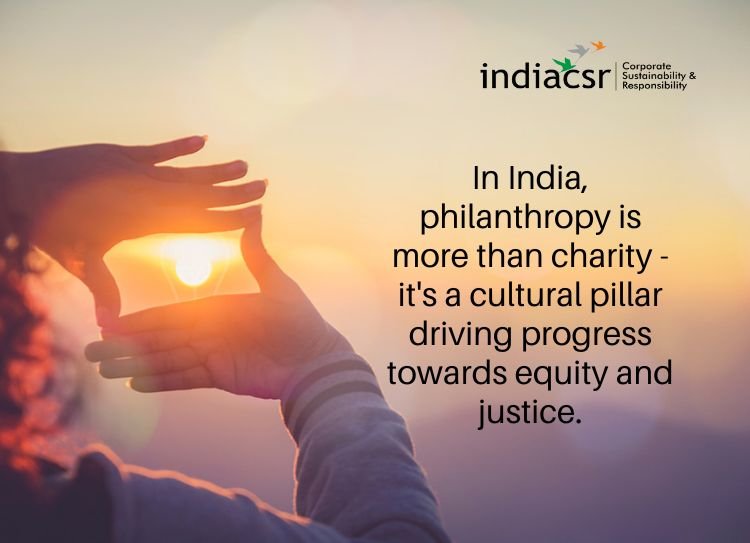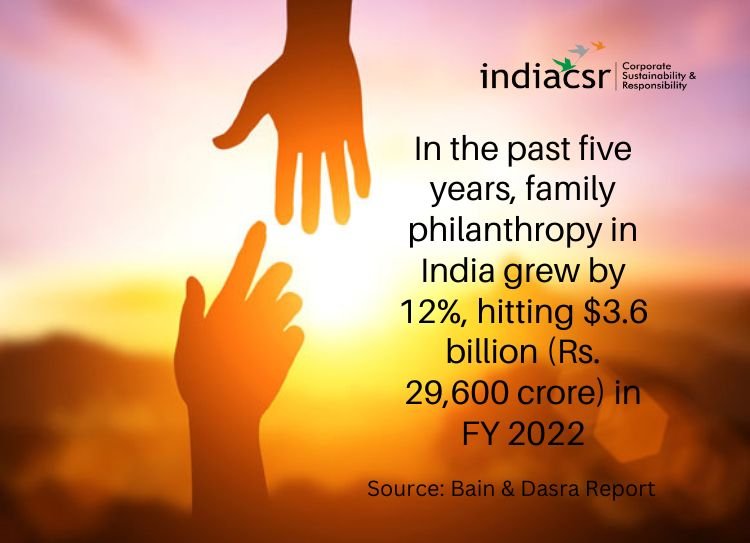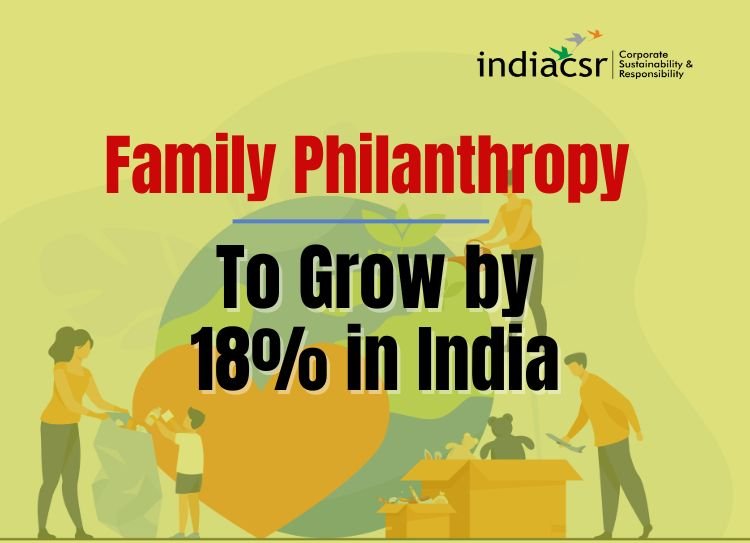Philanthropy has deep roots in India, where giving back to society is traditionally seen as a grateful acknowledgment of personal prosperity and contentment.
Philanthropy holds a prominent place in Indian society, with family philanthropy becoming an institutionalized way for families to contribute to social causes. Recently, family philanthropy has seen significant growth, expected to continue at a robust rate of around 18% from FY22 to FY27. However, various challenges need to be addressed for it to achieve its full potential in driving sustainable and inclusive development in India. There is a long tradition of philanthropy in India and the concept of “giving back” to society is regarded as an expression of gratitude for one’s prosperity and pleasure. Many individuals and families believe it is their moral mission to help the less fortunate in order to create a more equitable and just society.
The Institutionalization of Family Philanthropy
The idea of contributing by families is now institutionalized through family philanthropy, where members collectively contribute to social causes and development. Over the years, this practice has grown significantly, and recent data indicates a notable surge in family philanthropy. According to the Bain & Dasra Report, family philanthropy has witnessed a remarkable 12% growth over the last five years, reaching an impressive $3.6 billion (INR 29,600 crore) in FY 2022. This growth can be attributed to the increased involvement of High-Net-Worth Individuals (HNIs) and affluent givers who have a net worth ranging from INR 7 to 200 crore.
Sustained Commitment to Social Impact
The positive trend is expected to continue in the coming years, as the India Philanthropy Report 2023 predicts that family philanthropy will grow at a robust CAGR of approximately 18% from FY22 to FY27. This anticipated growth indicates a sustained and increasing commitment from families towards making a positive impact on society and addressing pressing social challenges.

The Potential of Family Philanthropy in Development
Amitabh Jaipuria, CEO, Accelerate Indian Philanthropy (AIP), said, “Family philanthropy can catalyze economic and social transformation by providing flexible long-term funding, taking big bets in funding R&D and systems level change, and looking at underserved niche sectors such as art & culture, sports development, mental health.”
Key Highlights
| Fact | Details |
|---|---|
| Tradition of Philanthropy in India | Long-standing; viewed as a way of giving back to society. |
| Family Philanthropy | Institutionalized through collective contributions to social causes and development. |
| Recent Growth of Family Philanthropy | 12% growth over the last five years; reaching $3.6 billion (INR 29,600 crore) in FY 2022. |
| Major Contributors | High-Net-Worth Individuals (HNIs) and affluent givers with a net worth ranging from INR 7 to 200 crore. |
| Projected Growth | Expected to grow at a CAGR of approximately 18% from FY22 to FY27 according to the India Philanthropy Report 2023. |
| Potential Impact | Can catalyze economic and social transformation by providing long-term funding, supporting underserved sectors, and building larger impact groups. |
| Challenges | Geographical inaccessibility, infrastructural limitations, and lack of awareness among potential donors. |
| Proposed Solutions | Effective governance, impact investing, collaboration with other donors, data-driven decision-making, and focusing on underrepresented regions and social issues. |
| Imbalance in Funding Allocation | More funds allocated to health and education; less focus on gender-focused initiatives and disability intersections. |
| Future of Family Philanthropy in India | Potential to lead the country’s philanthropic movement; need to address gaps between philanthropists and fund seekers for sustainable development. |
Potential Impact of Family Philanthropy
Moreover, the influence of a family is always much more significant than that of an individual. As a result, it brings a diverse network of potential contributors to the table. Additionally, when the restrictions on family philanthropy are not as harsh as on other forms of philanthropy, it can build a much larger impact group by fostering initiatives that create a level playing field for vulnerable groups.
Challenges in the Current Philanthropy Landscape
Interestingly, 90% of philanthropists possess both the means and the desire to support social justice initiatives that champion diversity, gender parity, and inclusivity. However, obstacles such as geographical inaccessibility, infrastructural limitations, and a dearth of awareness among potential donors obstruct our path forward. To overcome these obstacles, there is a need to adopt new models and indicators of growth like effective governance, impact investing, collaboration with other donors, and data-driven decision-making, which can help them allocate their resources more effectively. Family philanthropy organizations can overcome obstacles and have a bigger influence on the communities they serve by using these innovative models and strategies.

The Imbalance in Philanthropic Funding Allocation
As of today, several reports pontificate on the imbalance in funding by philanthropists. The proportions of funds allocated to health and education-oriented programs exceed the share of gender-focused initiatives. Often disability and other intersections are overshadowed in the process of philanthropic funding. Such a mismatch can aggravate inequalities, becoming a hindrance to the collective growth of society too.
Proposing Innovative Approaches to Philanthropic Funding
Adopting new models and indicators of growth to identify key social issues can be transformational in channeling the fund-giving process. For example, recognizing the intersectionality between gender, class, and disability and acknowledging their impact on access to education and opportunities can be a big step. Moreover, shifting focus from metropolitan cities to more remote areas such as the northeast can lead to a more meaningful social movement. This will be conducive to bringing the least noticed problems to the limelight, which can resolve one of the difficulties mentioned previously – the dearth of awareness among willing donors.
The Future of Family Philanthropy in India
At present, family philanthropy in India has immense potential to lead the country’s philanthropic movement, driving sustainable and inclusive development at the policy level. However, the projected 18% growth in family philanthropy by the Indian Philanthropy Report 2023 is not enough to meet growing demands. The need of the hour is to fill in the gaps between family philanthropists and fund seekers to impact investment purposes. Nurturing this valuable family-driven giving system can be transcendental in the growth of Indian society as a whole.

Family Philanthropy: Purpose, Forms and Benefits Explained
Family philanthropy is a form of charitable giving that is undertaken by a family or multi-generational family group. Family philanthropy can be a rewarding way to give back to your community and pass on your values to future generations. With careful planning and execution, you can create a lasting legacy of philanthropy for your family.
It can take many forms, including:
Donating money to charities. This is the most common form of family philanthropy. Families can donate money to support the causes they care about, such as education, healthcare, or environmental protection.
Creating a private foundation. A private foundation is a charitable organization that is funded by a family or individual. Foundations can make grants to other charities, or they can operate their own programs.
Launching a giving circle. A giving circle is a group of individuals who pool their money together to make grants to charities. Giving circles are a great way for families to get involved in philanthropy together.
Volunteering time. Families can also give back to their communities by volunteering their time. This can be a great way to bond as a family and make a difference in the world.
Benefits
Family philanthropy can have many benefits. It can:
Strengthen family bonds. When families work together to give back to their communities, it can help them to bond and learn from each other.
Pass on values. Family philanthropy can be a way for families to pass on their values to future generations. When children see their parents and grandparents giving back to others, they learn the importance of compassion and generosity.
Make a difference in the world. Family philanthropy can help to make a real difference in the world. By supporting charities that are working to address important issues, families can help to create a better future for everyone.
If you are interested in getting involved in family philanthropy, there are many resources available to help you get started. The National Center for Family Philanthropy (NCFP) is a great place to learn more about family philanthropy. NCFP offers a variety of resources, including educational materials, workshops, and networking opportunities.
Tips for Getting Started
Here are some additional tips for getting started with family philanthropy:
- Talk to your family about your values and interests. What causes are you passionate about? What do you want your family’s philanthropic legacy to be?
- Set goals for your giving. How much money do you want to donate each year? What causes do you want to support?
- Find a giving vehicle that works for your family. There are many different types of giving vehicles available, such as private foundations, donor-advised funds, and giving circles. Choose a vehicle that meets your family’s needs and goals.
- Get involved in your community. Volunteer your time or attend events that support the causes you care about. This is a great way to learn more about the issues you are passionate about and make a difference in your community.
Read Stories on Recent Development in Philanthropy in India
Philanthropy Archives – India CSR








